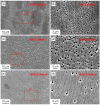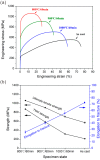Microstructural Evolution and Tensile Properties of Al0.3CoCrFeNi High-Entropy Alloy Associated with B2 Precipitates
- PMID: 35161159
- PMCID: PMC8840145
- DOI: 10.3390/ma15031215
Microstructural Evolution and Tensile Properties of Al0.3CoCrFeNi High-Entropy Alloy Associated with B2 Precipitates
Abstract
The room-temperature strength of Al0.3CoCrFeNi high-entropy alloys (HEAs) is relatively low owing to its intrinsic fcc structure. In the present study, the as-cast HEAs were subjected to cold rolling and subsequent annealing treatment (800, 900, and 1000 °C) to adjust the microstructures and tensile properties. This treatment process resulted in the partial recrystallization, full recrystallization, and grain coarsening with increasing the annealing temperature. It was found that the large and spherical B2 precipitates were generated in the recrystallized grain boundaries of three annealing states, while the small and elongated B2 precipitates were aligned along the deformation twins in the non-recrystallized region of the 800 °C-annealing state. The former B2 precipitates assisted in refining the recrystallized grains to quasi ultra-fine grain and fine grain regimes (with the grain sizes of ~0.9, ~2.2, and ~7.2 μm). The tensile results indicated that the decreased annealing temperature induced the gradual strengthening of this alloy but also maintained the ductility at the high levels. The yield strength and ultimate tensile strength in 800 °C-annealed specimen were raised as high as ~870 and ~1060 MPa and the ductility was maintained at ~26%. The strengthening behavior derived from the heterogeneous microstructures consisting of quasi ultra-fine recrystallized grains, non-recrystallized grains, deformation twins, dislocations, and B2 precipitates. Current findings offer the guidance for designing the HEAs with good strength and ductility.
Keywords: B2 precipitates; high-entropy alloy; microstructures; strengthening; tensile properties.
Conflict of interest statement
The authors declare no conflict of interest.
Figures














Similar articles
-
The Recrystallized Microstructures and Mechanical Properties of a Hypo-Eutectic Al13Ni36Cr10Fe40Mo1 High-Entropy Alloy.Materials (Basel). 2025 May 23;18(11):2454. doi: 10.3390/ma18112454. Materials (Basel). 2025. PMID: 40508453 Free PMC article.
-
Simultaneous Strength-Ductility Enhancement of a Nano-Lamellar AlCoCrFeNi2.1 Eutectic High Entropy Alloy by Cryo-Rolling and Annealing.Sci Rep. 2018 Feb 19;8(1):3276. doi: 10.1038/s41598-018-21385-y. Sci Rep. 2018. PMID: 29459746 Free PMC article.
-
Heterogeneous Microstructure and Tensile Properties of Fe50Mn30Co10Cr10 Metastable High-Entropy Alloy.Materials (Basel). 2024 Dec 1;17(23):5893. doi: 10.3390/ma17235893. Materials (Basel). 2024. PMID: 39685328 Free PMC article.
-
Tailoring microstructure of Mg-Zn-Y alloys with quasicrystal and related phases for high mechanical strength.Sci Technol Adv Mater. 2014 Jul 18;15(4):044803. doi: 10.1088/1468-6996/15/4/044803. eCollection 2014 Aug. Sci Technol Adv Mater. 2014. PMID: 27877701 Free PMC article. Review.
-
Nanoprecipitate-Strengthened High-Entropy Alloys.Adv Sci (Weinh). 2021 Dec;8(23):e2100870. doi: 10.1002/advs.202100870. Epub 2021 Oct 22. Adv Sci (Weinh). 2021. PMID: 34677914 Free PMC article. Review.
References
-
- Yeh J.W., Chen S.K., Lin S.J., Gan J.Y., Chin T.S., Shun T.T., Tsau C.H., Chang S.Y. Nanostructured high-entropy alloys with multiple principal elements: Novel alloy design concepts and outcomes. Adv. Eng. Mater. 2004;6:299–303. doi: 10.1002/adem.200300567. - DOI
-
- Cantor B., Chang I.T.H., Knight P., Vincent A.J.B. Microstructural development in equiatomic multicomponent alloys. Mater. Sci. Eng. A. 2004;375–377:213–218. doi: 10.1016/j.msea.2003.10.257. - DOI
-
- Biswas K., Yeh J.W., Bhattacharjee P.P., De Hosson J. High entropy alloys: Key issues under passionate debate. Scr. Mater. 2020;188:54–58. doi: 10.1016/j.scriptamat.2020.07.010. - DOI
-
- Zhang Y., Zuo T.T., Tang Z., Gao M.C., Dahmen K.A., Liaw P.K., Lu Z.P. Microstructures and properties of high-entropy alloys. Prog. Mater. Sci. 2014;61:1–93. doi: 10.1016/j.pmatsci.2013.10.001. - DOI
Grants and funding
LinkOut - more resources
Full Text Sources
Miscellaneous

